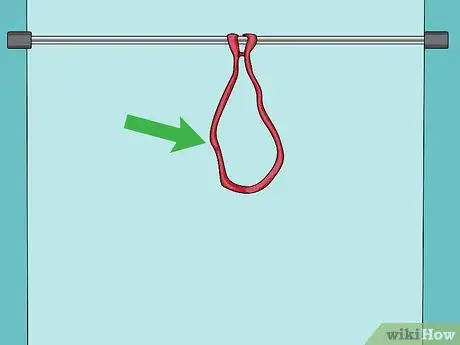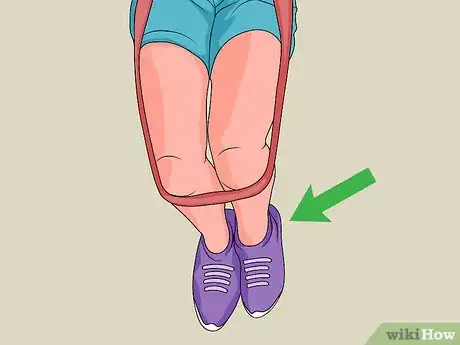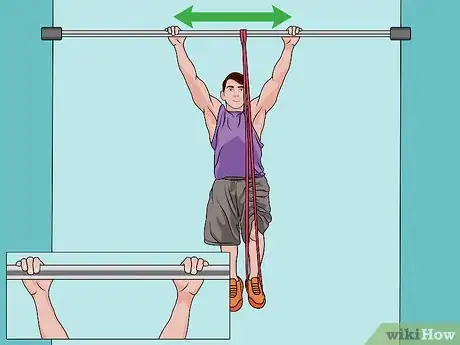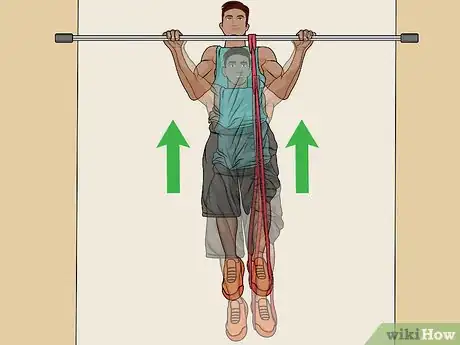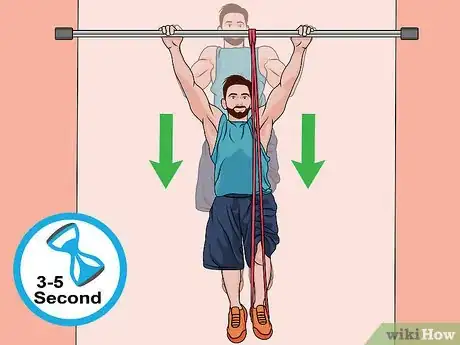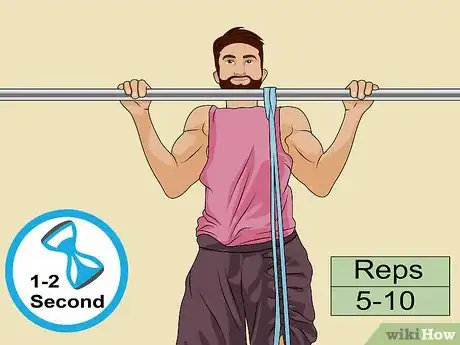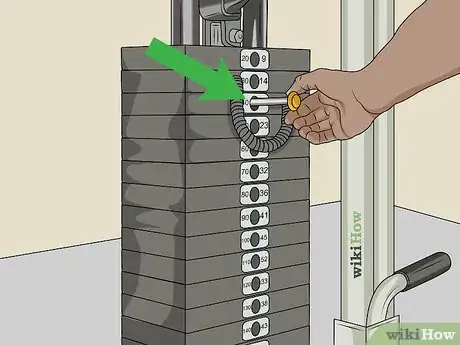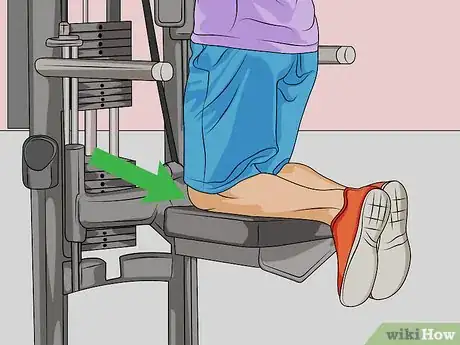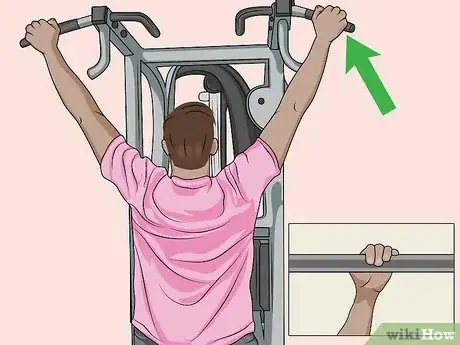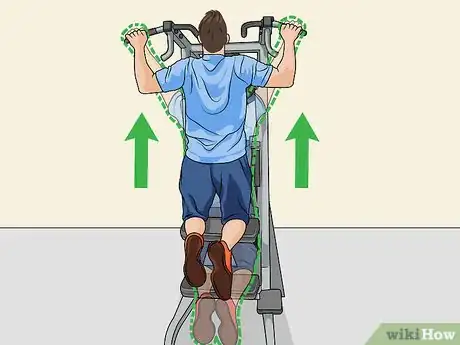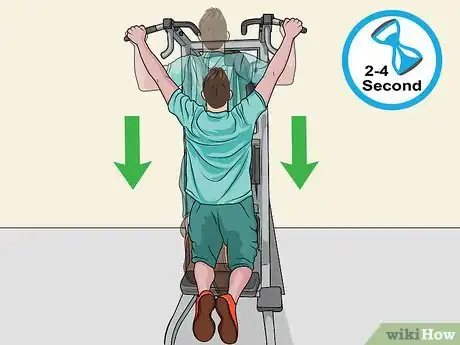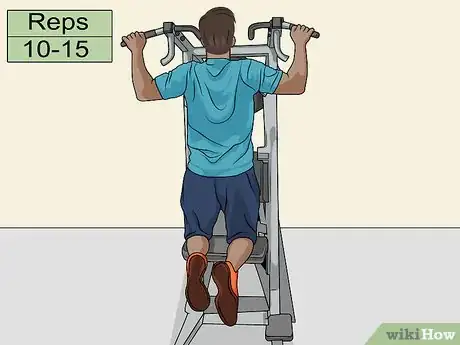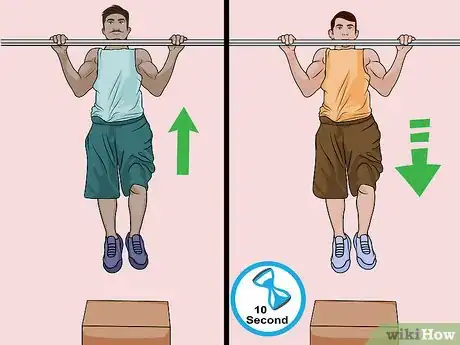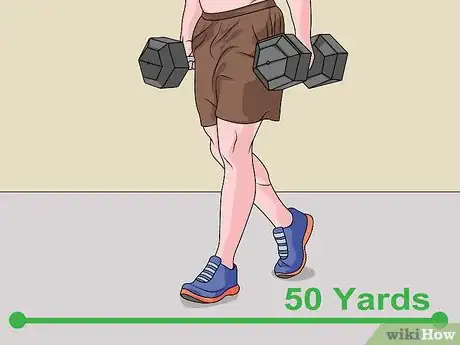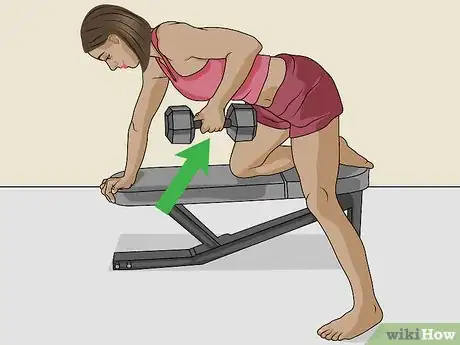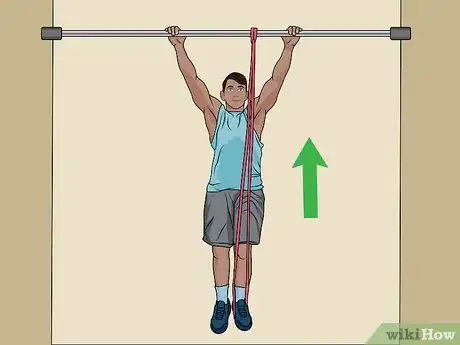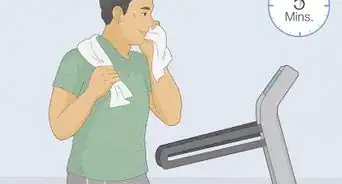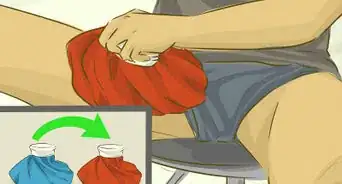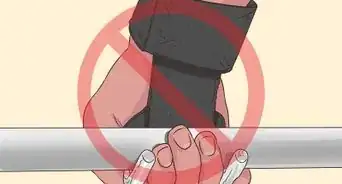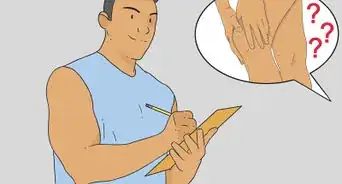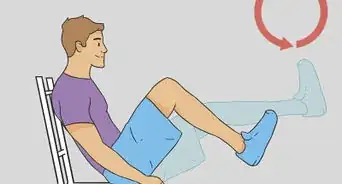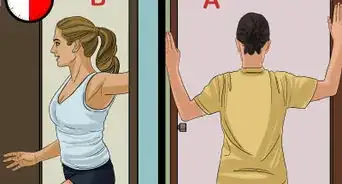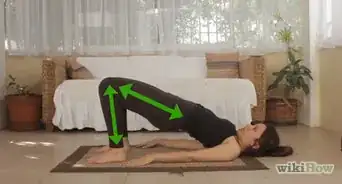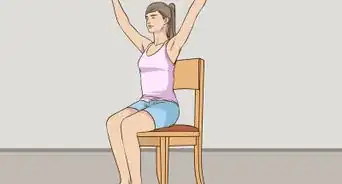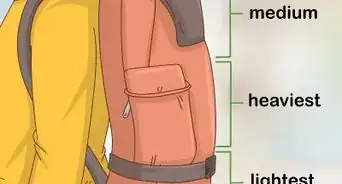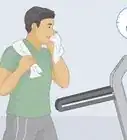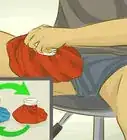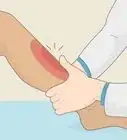This article was co-authored by Julian Arana, M.S.eD., NCSF-CPT and by wikiHow staff writer, Jennifer Mueller, JD. Julian Arana is a Personal Trainer and the Founder of B-Fit Training Studios, a personal training and wellness set of studios based in Miami, Florida. Julian has over 12 years of personal training and coaching experience. He is a certified personal trainer (CPT) by the National Council on Strength and Fitness (NCSF). He has a BS in Exercise Physiology from Florida International University and an MS in Exercise Physiology specializing in strength and conditioning from the University of Miami.
This article has been viewed 19,089 times.
Bodyweight pull-ups are difficult exercises that really test the strength of your back and arms. If you can't do a pull-up, however, you may be able to do an assisted pull-up, either by using exercise bands or by using an assisted pull-up machine at a gym. To perform assisted pull-ups, maintain your form and make sure you're doing the work yourself rather than relying too much on the assistance.[1]
Steps
Doing Band-Assisted Pull-Ups
-
1Set up your equipment. Choose bands of the correct length and secure them over the top of a pull-up bar. Adjust the length or the band so that it does not reach the ground when you are standing on it.[2]
- You may have to adjust the length of the band several times to get it correct.
- You should be able to hang off the bar and place your feet in the band without your feet touching the ground.
- If you're looping the band around your knees, you'll need to adjust it so that it's shorter.
-
2Place your feet or knees in the band. You can do band-assisted pull-ups either by standing inside the band or looping the band under your knees. If you loop the band under your knees, you'll need to keep your knees bent as you perform your pull-ups.[3]
- You also can put only one foot or knee in the band, if this is more comfortable. The band may provide less assistance this way.
-
3Grip the bar. To perform a pull-up, you want to use an overhand grip. Chin-ups are another exercise similar to pull-ups that use an underhand grip. Keep in mind that pull-ups are usually more difficult than chin-ups.[4]
- In hanging position, your arms should be straight.
- Grip the bar with your hands a little wider than shoulder-width apart. Your arms shouldn't touch your ears. Don't grip too wide, however, or you'll significantly decrease your range of motion.
-
4Pull yourself up to the bar. Take a few deep breaths, then pull yourself up in a slow, steady motion, driving your elbows towards your side in a pumping motion. The band will make it easier for you to lift your body weight.[5]
- Avoid swinging or pushing from your hips. You should be pulling up your body weight, not using any momentum from your lower body.
- You also want to avoid jerky movements. Your pull-up should be a relatively slow, controlled movement.
- Raise your entire head and neck over the bar. Don't strain your chin or neck to reach over the bar – the work should be done by your back, making sure to keep your shoulders down.
- Keep in mind that the band will provide progressively less assistance as you pull yourself up.
-
5Lower slowly. Once you've completed your pull-up, follow through with the rest of the exercise by controlling your movement when you lower so that your muscles are doing the work to actively lower your body.[6]
- Simply allowing your body to drop after the exercise can put you at risk for injury.
- Aim for your descent to take between three and five seconds.
- The bands will assist you to some degree to control your movement and lighten your load as you lower your body.
-
6Pause in the hang position between reps. Breathe deeply and remain in this position for one or two seconds before you do another pull-up.[7]
- Pull-ups are challenging exercises, so don't overdo it. A couple of sets of between 5 and 10 reps is sufficient.
- If you're just starting out with pull-ups, do fewer reps at first. You can add reps as you get stronger and more skilled.
Completing Machine-Assisted Pull-Ups
-
1Add weight to the machine. Unlike other weight machines, the more weight you add to an assisted pull-up machine, the easier the exercise will be for you. The machine counterbalances your weight with the weight you add to the machine.[8]
- Start with more weight than you think you'll need, and experiment with different weight until you find a level that's challenging without being too much.
- Generally, you should be able to do several reps with the weight, but no more. In other words, if you're planning to do 10 pull-ups, set the weight that is just enough to enable you to do 10 pull-ups.
-
2Stand or kneel on the platform. Depending on how the machine is designed, you'll start your pull-ups from either a standing or kneeling position. Check the resistance on the platform and make sure you're comfortable and well balanced.[9]
- Make sure the platform is adjusted appropriately for your height. Your arms should be completely straight when you reach up to grab the handles.
-
3Use an overhand grip on the handles. An assisted pull-up machine has two handles, one on either side of the machine. These handles are approximately the same width apart as your hands should be when using a pull-up bar.[10]
- Due to the position of the handles, it would be difficult or awkward to use anything other than an overhand grip. If you attempt to use an underhand grip, you'll have to twist your arms in a way that your elbows won't bend to do a pull-up.
- Your arms should be completely straight to begin your machine-assisted pull-ups, with your elbows locked.
- Be careful not to hyperextend your elbows – you could injure yourself.
-
4Pull yourself up between the handles. When you're ready, pull yourself up using a similar form to the one you would use if you were doing a pull-up on a regular pull-up bar. You'll feel the weight kick in to assist you as you complete the motion.[11]
- You should pull yourself up so that your chin is over the level of the top of the handles. Use a pumping motion, driving your elbows towards your side.
- Don't strain or pull with your neck, and keep your shoulders down. Keep your hips and torso as still and straight as possible, without swinging or pumping from your hips.
-
5Lower yourself in a slow and controlled way. As you lower your body, keep your movements controlled and let your muscles do the work rather than either relying on the assistance from the machine or allowing your body to drop by force of gravity.[12]
- Focus on taking between two and four seconds to lower your body back to your starting position.
- When you've completely lowered yourself with your arms extended, pause for a couple of seconds before you do your next pull-up.
-
6Complete 10 to 15 reps per set. Generally, machine-assisted pull-ups won't help you progress towards unassisted pull-ups unless you take responsibility for the work and do multiple reps to build the strength in your muscles.[13]
- However, you should take advantage of the assistance provided by the machine to do multiple reps that you might not be able to do with band-assisted pull-ups or unassisted pull-ups.
- Doing 10 to 15 pull-ups on an assisted pull-up machine is a reasonable goal.
- After you've finished your reps, make sure you're removing the weights and returning the machine to its default position so it's ready for the next user.
Progressing to Unassisted Pull-Ups
-
1Do jump negatives. Jump negatives work on the eccentric or negative part of the pull-up exercise, when you lower your body after having performed the pull-up. This builds strength in your arms and will improve the quality of your pull-up technique and performance.[14]
- To do a jump negative, start by standing on a stool and gripping the bar with an overhand grip.
- Rather than pull yourself up, you're going to jump up so your chin is level with the bar. Be careful you don't hit your face on the bar — you're not trying to hook your chin over it. You just want it to be level with the bar.
- Then, lower yourself slowly, focusing on controlling your movement and resisting gravity as much as you can.
- Try to go slowly enough that you can count to 10 before your feet touch the ground.
-
2Work on your grip. Grip strength can be a key factor in many pulling exercises including pull-ups. Improving your grip strength will make it easier for you to do unassisted pull-ups, and also make you feel more secure when doing pull-ups – whether assisted or not.[15]
- A variation of an exercise called the farmer's walk is one way to work on your grip strength.
- To do this exercise, carry a pair of heavy dumbbells or another heavy object and walk a considerable distance – 50 yards or so can be one set. After that distance, rest for a minute before doing it again.
- If you do two or three sets several times a week, over time your grip strength will increase.
-
3Strengthen your back with rowing exercises. Doing rowing exercises or using a rowing machine can strengthen your back and shoulders as well as your arms. These are some of the same muscles you use when you perform pull-ups.[16]
- Dumbbell and barbell rows also can help you build your back muscles.
- Pick several exercises that you like and incorporate them in your regular strength-training sessions so you can work towards performing unassisted pull-ups.
-
4Gradually decrease the weight you add on machine-assisted pull-ups. Assisted pull-up machines can be used to progress to unassisted pull-ups provided you regularly decrease the weight that you add the machine to assist you.[17]
- For example, if you started doing machine-assisted pull-ups putting the same amount of weight on the machine as your own weight, consider decreasing this amount by 5 percent each week so that you're regularly decreasing the assistance you get.
- You also could try doing one or two pull-ups with significantly less weight on the machine, then add weight to do additional reps.
-
5Perform an advanced modification of band-assisted pull-ups. If you want to transition from assisted pull-ups to unassisted pull-ups, you can do a variation that gives you less assistance lowering your body than a normal band-assisted pull-up does.[18]
- To do this modification, you'll have to loop the band around your feet rather than around your knees.
- When you pull yourself up, lift your legs and tuck them towards your chest. Now you're out of the band, so as you lower yourself you won't get any assistance from the band.
Expert Q&A
-
QuestionDo assisted pull ups build muscle?
 Julian Arana, M.S.eD., NCSF-CPTJulian Arana is a Personal Trainer and the Founder of B-Fit Training Studios, a personal training and wellness set of studios based in Miami, Florida. Julian has over 12 years of personal training and coaching experience. He is a certified personal trainer (CPT) by the National Council on Strength and Fitness (NCSF). He has a BS in Exercise Physiology from Florida International University and an MS in Exercise Physiology specializing in strength and conditioning from the University of Miami.
Julian Arana, M.S.eD., NCSF-CPTJulian Arana is a Personal Trainer and the Founder of B-Fit Training Studios, a personal training and wellness set of studios based in Miami, Florida. Julian has over 12 years of personal training and coaching experience. He is a certified personal trainer (CPT) by the National Council on Strength and Fitness (NCSF). He has a BS in Exercise Physiology from Florida International University and an MS in Exercise Physiology specializing in strength and conditioning from the University of Miami.
Certified Personal Trainer Yes, basically any form of the pull up where there's resistance is going to help you build muscle. When you do a pull up, you're lifting your own body weight. That's ostensibly the same thing as lifting a free weight.
Yes, basically any form of the pull up where there's resistance is going to help you build muscle. When you do a pull up, you're lifting your own body weight. That's ostensibly the same thing as lifting a free weight.
References
- ↑ http://www.niashanks.com/band-assisted-pullup/
- ↑ http://www.niashanks.com/band-assisted-pullup/
- ↑ http://www.niashanks.com/band-assisted-pullup/
- ↑ http://www.niashanks.com/band-assisted-pullup/
- ↑ http://www.niashanks.com/band-assisted-pullup/
- ↑ http://www.niashanks.com/band-assisted-pullup/
- ↑ http://www.niashanks.com/band-assisted-pullup/
- ↑ https://www.verywell.com/how-to-do-assisted-pullups-and-dips-3498284
- ↑ https://www.verywell.com/how-to-do-assisted-pullups-and-dips-3498284
- ↑ https://www.verywell.com/how-to-do-assisted-pullups-and-dips-3498284
- ↑ https://www.verywell.com/how-to-do-assisted-pullups-and-dips-3498284
- ↑ https://www.verywell.com/how-to-do-assisted-pullups-and-dips-3498284
- ↑ https://www.verywell.com/how-to-do-assisted-pullups-and-dips-3498284
- ↑ http://www.bodybuilding.com/fun/yes-you-can-do-pull-ups-for-major-reps-heres-how.html
- ↑ http://www.bodybuilding.com/fun/yes-you-can-do-pull-ups-for-major-reps-heres-how.html
- ↑ http://www.bodybuilding.com/fun/yes-you-can-do-pull-ups-for-major-reps-heres-how.html
- ↑ https://www.verywell.com/how-to-do-assisted-pullups-and-dips-3498284
- ↑ http://www.niashanks.com/band-assisted-pullup/
